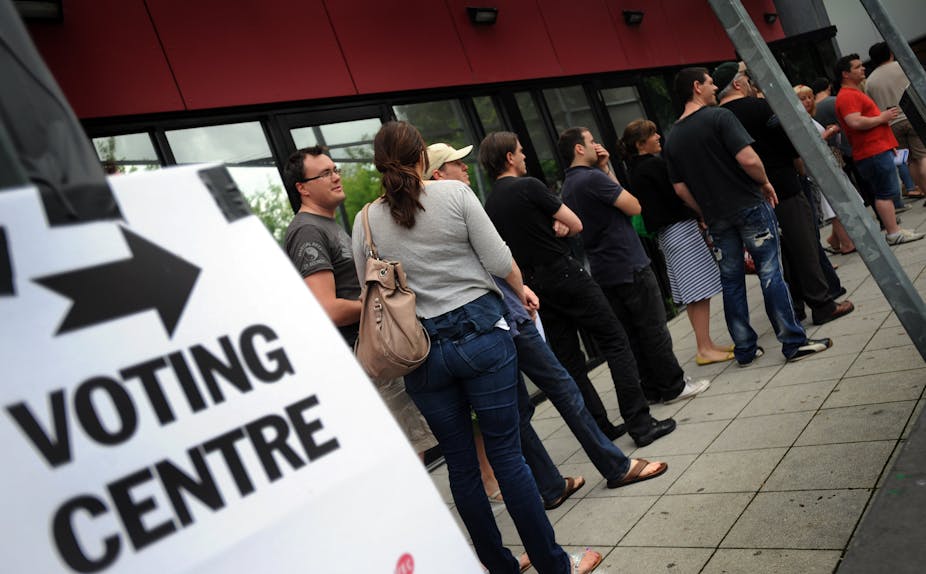The looming byelection in the state seat of Melbourne is set to have a national impact.
With Greens candidate Cathy Oke strongly tipped to beat Labor’s Jennifer Kanis on 21 July - the first time the ALP will have lost the seat in more than a century - the flow-on effects may reach all the way to Canberra.
The likely Labor loss is being touted as a vote against the party brand. But Prime Minister Julia Gillard argues that voters “understand they’re voting for a seat in the state parliament.”
This comes after a week of Labor attacks on the Greens and arguments over preferences at the federal level.
Will the Melbourne byelection be about local issues? Or will disenchantment with federal Labor spark a Green win in a seat they already hold federally? La Trobe University’s Dr Ardel Shamsullah looks at why the seat of Melbourne is unique and how it has come to be seen as Greens territory.
Does the state seat of Melbourne reflect “mainstream Australia” in a political and economic sense?
Decidedly not, it’s a very unusual seat. Within the Victorian context, it’s the youngest seat with the largest number of young adults, and with the highest proportion of tertiary students. It’s the seat, I think with the highest proportion of renters, lowest proportion of home owners. And in terms of working families, it’s the seat with the lowest proportion of families with dependent children in Victoria.
So it’s a very unusual seat, but all these factors make it eminently part of the Green demographic – a seat which the Greens should perform strongly in. It ticks all their boxes.
Is the inner Melbourne area now “natural” or “safe” Green territory?
What initially started out as gentrification of these areas, which seemed likely to turn some of those industrial inner city seats from Labor to Liberal has moved on to a sort of post-industrial, post-materialist demographic.
That’s tilted it away from both Labor and Liberal to the emerging Greens party.
The Greens have gained strength and support over the past few election cycles as they’ve matured as a party. But in electoral terms, the position of the Liberal party worked against them at the last election.
Ted Baillieu took a strong stand and decided to direct preferences to the ALP ahead of the Greens. So it was Liberal preferences, the bulk of which flowed to Labor allowing [retiring member] Bronwyn Pike to retain the seat. But he shored up his support in the Liberal heartland by coming out so defiantly against the Greens.
Also because the Baillieu government is not contesting, in no way can this be seen as any sort of barometer of electoral enchantment or disenchantment with the Baillieu government. It’s tactically wise as it avoids contesting in a seat where they inevitably would finish third.
Is Julia Gillard being set up for a fall by her own party, perhaps in order to trigger a leadership challenge?
The message from people like [NSW ALP secretary] Sam Dastyari is directed towards socially conservative former Labor voters who have gone across to the Liberals. And it’s not really directed at the peculiar character of the city seats where the Greens have become strong in recent years.
Urging Labor supporters to repudiate the Greens, even if that goes down well in the outer suburbs, it would work against Labor’s chances in this by-election.
The Greens are being lambasted for policies which the great majority of the Melbourne state electorate support. Policies like a more accommodating line on asylum seekers, environmental awareness, action against climate change. The Greens are castigated for policies that people like Dastyari believe deter Labor support, but in the electorate of Melbourne it’s the Greens policies which resonate very strongly with the electorate.
Should the ALP accept the loss of areas like Melbourne and concentrate on shoring up its suburban vote, presuming Greens will never support a Liberal led government?
It’s inevitable that Labor can’t be all things to all people. But there’s clearly tension between the left, radical policies of the Greens and the more bread and butter, economically focused issues that the suburban majority of the Australian electorate would be most concerned about.
But Labor has tried to straddle a very broad range of constituencies and it may well be that some peculiar inner city electorates will become Green strongholds.
It raises the question of what the Labor party stands for. It was a party based on the trade union movement with strong working class orientation and a focus on material advancement and redistribution on behalf of the working class.
But because of these new constituencies that have emerged which could be called post-materialist, concerned about conservation, rights, social justice, Labor has found it increasingly difficult to accommodate the two camps.
I think Dastyari would like Labor to repudiate the post-materialists and return to what he sees as the majority, suburban heartland. It’s their traditional base, but it’s evolving from unionised blue collar to white collar and professional, but who are still family oriented, materialistic and relatively socially conservative.


